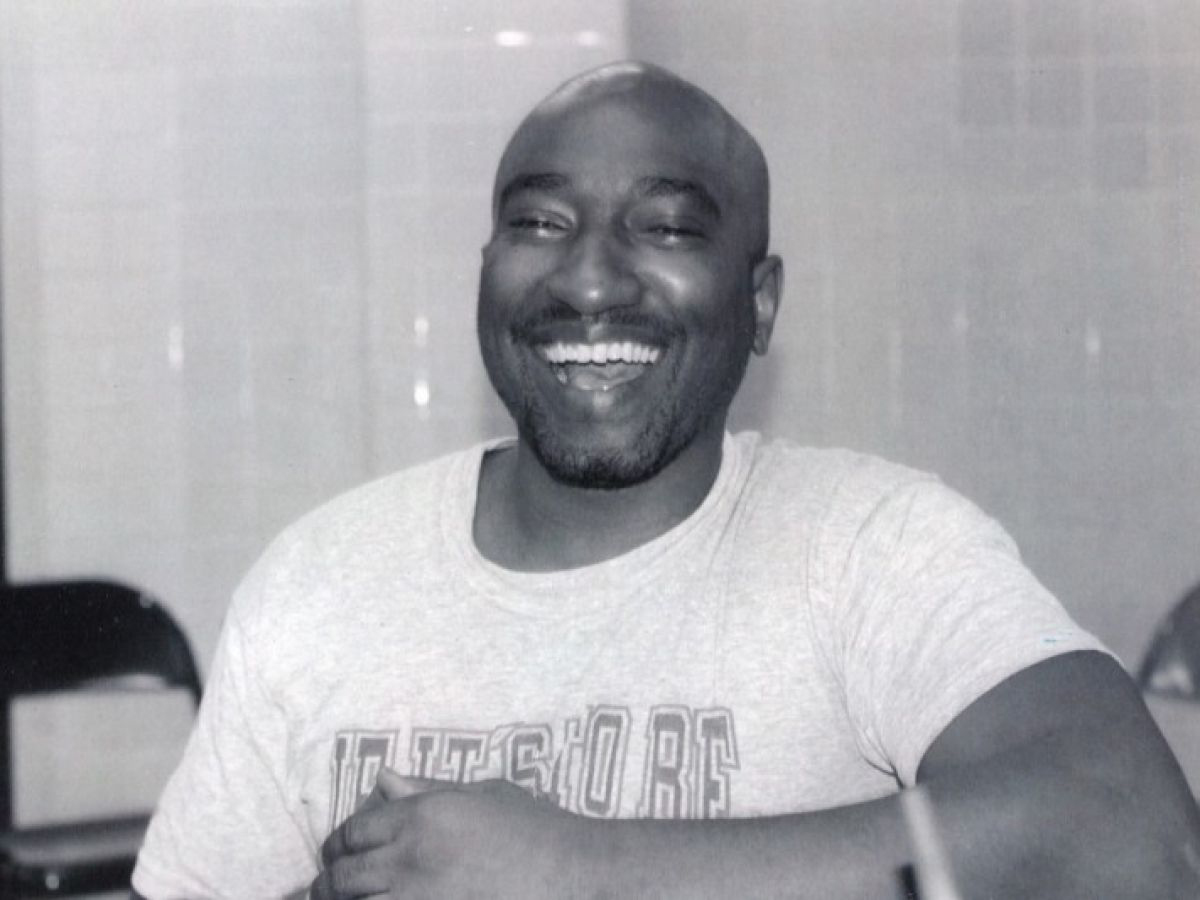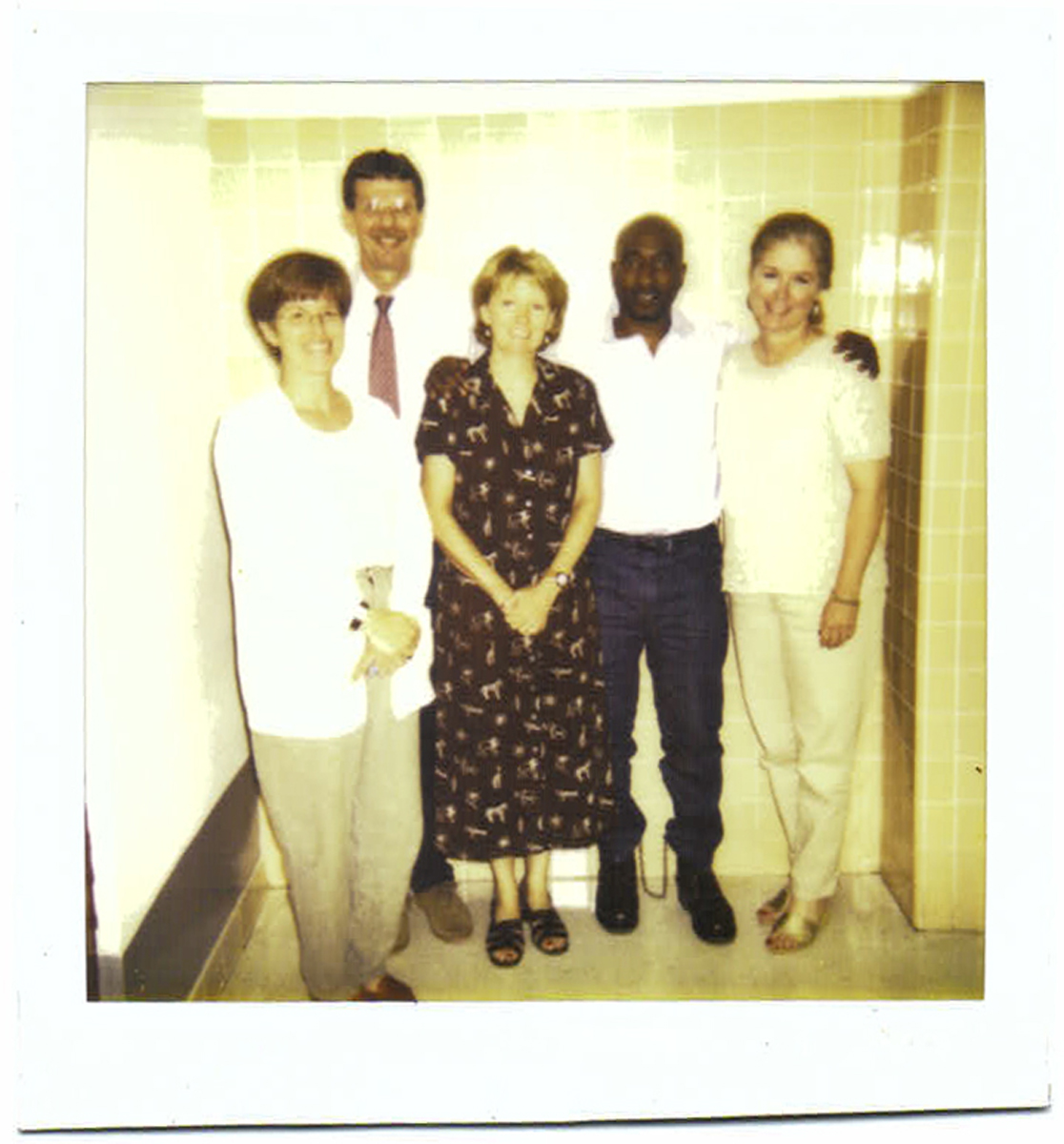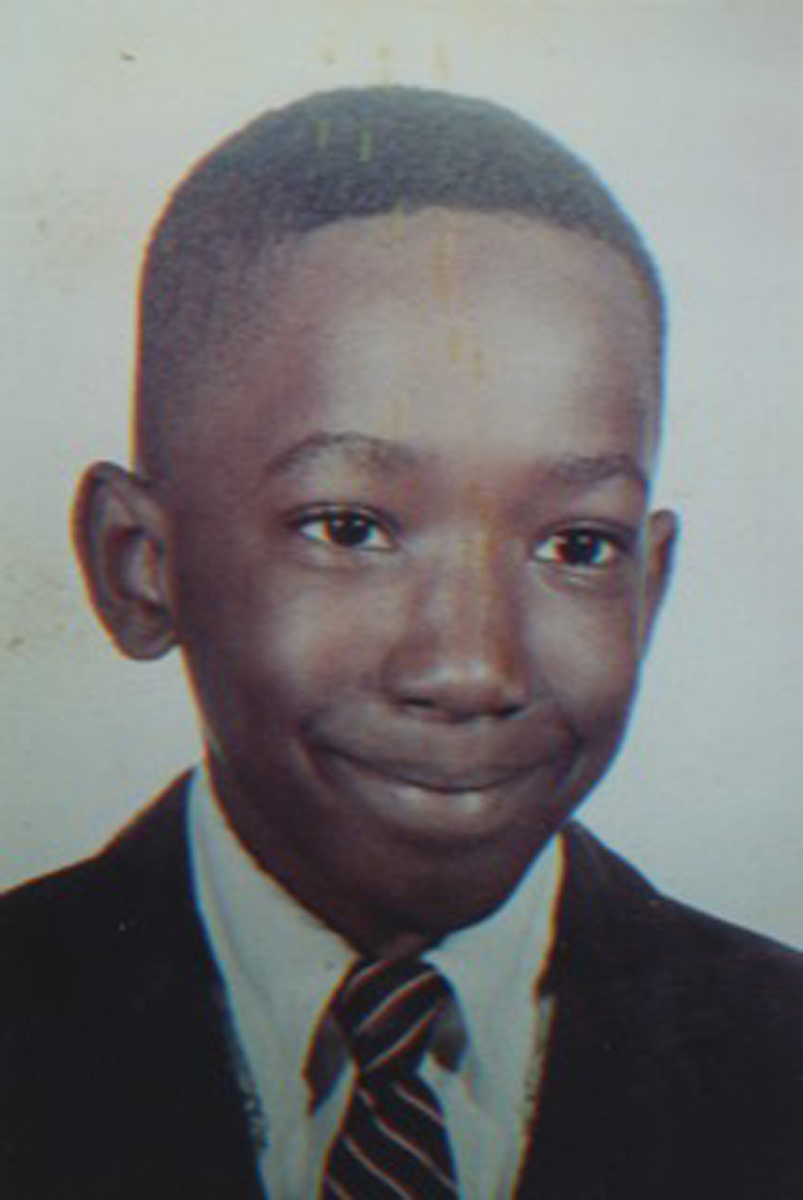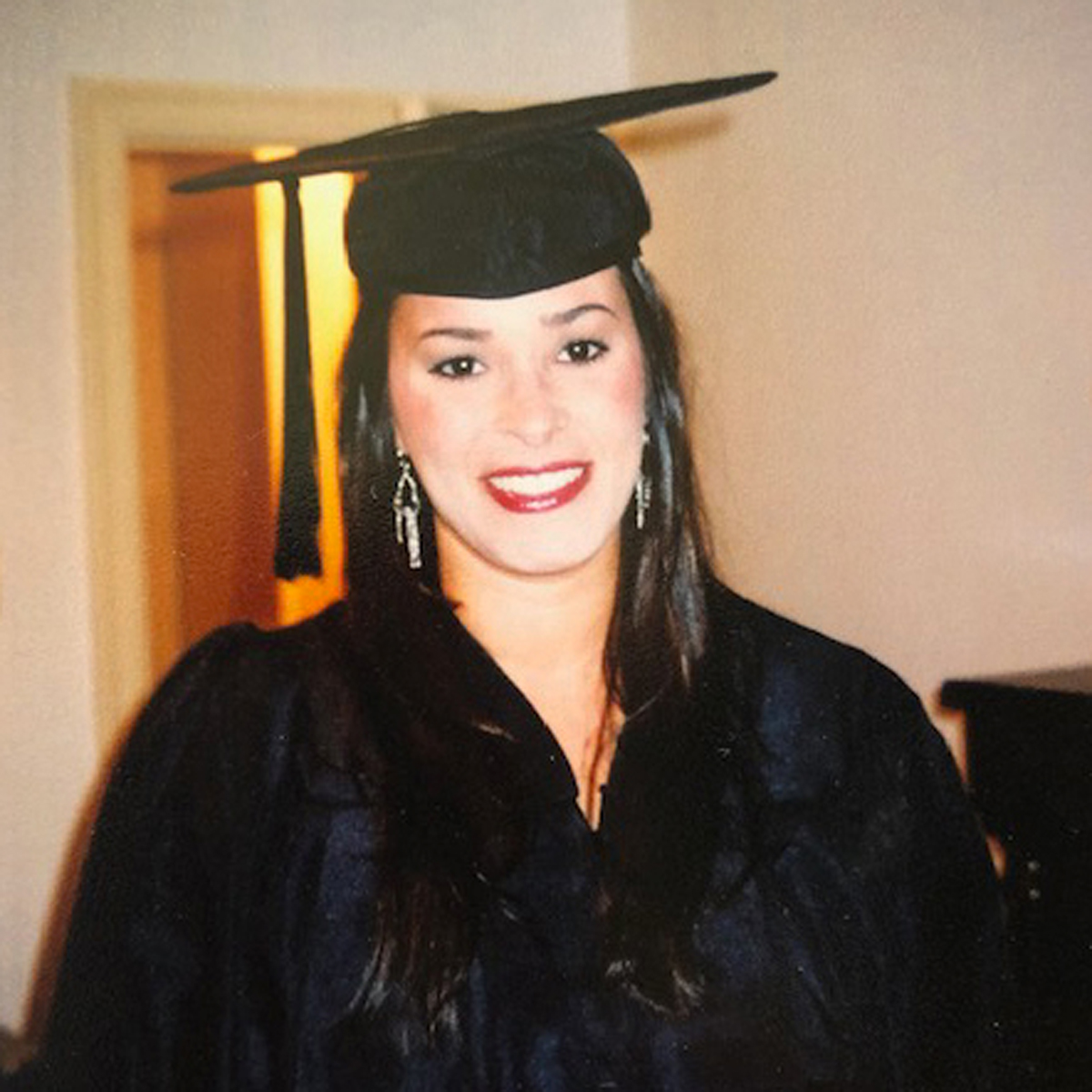A Long Time Coming—LSU Alumna Shines New Light on Incarceration and 20-Year-Old LSU Social Work Case
Louisiana State University (LSU) alumna Monique Morrison has optioned both the book rights and the story rights related to a death penalty mitigation case researched by LSU Professor of Research and Director Emerita of the LSU Social Research and Evaluation Center Cecile Guin in the late ’90s. Morrison now has plans for a TV series called The Farm to be centered around Angola Prison, the former slave plantation turned Louisiana State Penitentiary, where Feltus Taylor spent the last nine years of his life before his execution by lethal injection.

Feltus Taylor wrote prolifically while on death row and often signed his correspondence “Mr. Smile.”
BATON ROUGE, September 2, 2020 — There are two versions of this story.
In the first, a Black man named Feltus Taylor is born to a drug-addicted mother who
goes to prison. He is put into foster care, suffers severe developmental delays, gets
bullied and taken advantage of, commits an inexcusable and horrific act of violence,
and is sentenced to death. While on death row, he writes a children’s book and a manuscript
about his own life to help other young men, inspires fellow inmates, and gains the
support of two local churches—one Baptist, one Episcopalian—as well as lifelong friends
around the world.
In the second, a Black man named Feltus Taylor is a murderer. He shot and killed the
cook, Donna Ponsano, at the Cajun’s Fabulous Fried Chicken restaurant on Florida Boulevard
in Baton Rouge, from which he’d been recently fired. He also shot and permanently
injured the manager, Keith Clark, before driving off with a few hundred dollars in
cash from the register.
LSU Professor of Research Cecile Guin knows that both of these versions are true.
As Director of the LSU Office of Social Service Research and Development (now the
LSU Social Research and Evaluation Center) from 1996 to 2018, she worked on 115 death
penalty mitigation cases. Guin was hired, through contracts, by the public defender’s
office as an independent expert to research the life histories of the accused to help
explain to the juries why they did what they did, including committing murder. During
her tenure at LSU, Guin was awarded millions in grants and contracts.
“Working on these death penalty cases was great training for the social workers at LSU. You can learn an awful lot. About humanity and grace—and about racism, for sure. Discrimination, poverty. I don’t think anyone who worked on Feltus’s case wasn’t a changed person from the experience.”—Cecile Guin
“Doing forensic social work histories means developing a life story, but it’s done
in a manner that’s objective, completely factual, and honest,” Guin said. “It’s not
like you can take some good things and leave the bad things out. You have to pull
all of the stuff into it and tell the story of how that person got to that place in
their life.”
For Feltus Taylor’s case alone, Guin and her team tracked down and investigated hundreds
of records—from schools and juvenile institutions, medical records, birth records,
and court records. She and Jane Smith, an LSU colleague with whom she’d graduated
in 1978—both with Master of Social Work degrees from LSU—interviewed family members
and spent hundreds of hours with Feltus Taylor while he was on death row at Louisiana
State Penitentiary, the only maximum-security prison in the state, also known as Angola.
On a weekly basis and for years, Taylor would mail handwritten letters to Guin’s office
where student workers would type them up and add the hard copies to an increasingly
thick binder. Eventually, Guin and Taylor’s legal team helped create a foundation
just to safeguard his intellectual property.
Then, at 39 years old in the summer of 2000, Feltus Taylor was executed by lethal
injection. His lawyer and spiritual advisor were in the room with him, while Guin
stayed outside.

LSU Professor of Research Cecile Guin (center) coordinated with a team to support Feltus Taylor (second from right) while he was on death row. The team also included his lawyer Jean Faria (left), his spiritual advisor Charles deGravelles (second from left), and medical social worker Jane Smith (right), who was an LSU colleague and fellow graduate of Guin’s—they remain close friends and neighbors.
“I didn’t want to go to Feltus’s execution,” Guin remembered. “I didn’t want to see
him die. And it worked out in a way, because when you witness an execution, you have
to go into the room early, well ahead of time, while I was able to sit outside with
him until the moment he walked in.
Guin can recount many “strange stories,” as she calls them, about Feltus Taylor’s
faith and impact on others while on death row. Her own sister, who broke her neck
early in life but survived, ended up corresponding with Taylor and adopting his younger
next-cell neighbor, Jimmy Williams, who’d been 16 or 17 when he was convicted and
never went to high school. Today, Williams is no longer on death row and plans to
pursue a master’s degree in divinity. Taylor also, after his death, willed his personal,
“beautiful” Bible—originally a gift from his second spiritual advisor, Charles deGravelles—to
Guin’s sister. And one of Taylor’s first defense lawyers, Bonnie Jackson, who is a
District Court Judge in East Baton Rouge Parish, gave the eulogy for his funeral.
“It’s a difficult field, because in about 80 percent of the cases, you find out that these are good people who did bad things—people who could have been saved somewhere along the way—and the crime came down to circumstances.”—Cecile Guin
Feltus Taylor’s first spiritual advisor on death row was Sister Helen Prejean from
Baton Rouge, Louisiana, who wrote the book Dead Man Walking in 1993 (leading to the 1995 film starring Sean Penn and Susan Sarandon), a leading
American advocate for the abolition of the death penalty. Faith was a big part of
Taylor’s life and writing in prison, and Guin ended up hiring an LSU graduate student,
Ronlyn Domingue (now an author), to help shape his manuscript and make sure he shared
all aspects of his story.
“Feltus wrote prolifically, but when he talked about the murder, it was brief,” Guin
recalled. “So, Ronlyn had to push him a little. Also, he was gangraped when he was
in prison and tried to skirt over that, so she had to have a lot of difficult conversations
with him, about the things that really changed his life.”
Over time, Guin built a complex theoretical framework around the different pathways
that can affect how not just Feltus Taylor, but anyone, might go through life—physical
factors, mental factors, environment, substance abuse, family background, social connections,
money, education, and so on.
“Working on these death penalty cases was great training for the social workers at
LSU,” Guin said. “You can learn an awful lot. About humanity and grace—and about racism,
for sure. Discrimination, poverty. I don’t think anyone who worked on Feltus’s case
wasn’t a changed person from the experience.”
“But it’s a difficult field,” she continued. “Because in about 80 percent of the cases,
you find out that these are good people who did bad things—people who could have been
saved somewhere along the way—and the crime came down to circumstances.”
Guin wrote her doctoral dissertation on pathways to crime, following 832 young men
who left the Louisiana juvenile justice system to see where they ended up 12 years
later. Almost all of them were Black, about 85 percent—more than two-and-a-half times
the proportion of Black people in Louisiana (32 percent). She could only locate about
750 of the young men—now adults—but among them, at least 90 percent were in the adult
justice system, either on probation or in prison. For someone looking to find ways
to keep people out of the “school-to-prison pipeline” and pinpoint factors that could
help predict who would go on to adult jail and who wouldn’t, Guin’s findings were
less than encouraging. Later on, she was asked by the Louisiana legislature to research
why kids end up in the juvenile justice system in the first place and if there was
one thing they could do to help.

As a child, Feltus Taylor suffered severe developmental delays. Nobody was able to figure out what had happened to him in the first years of his life.
“We started with programs in Caddo Parish and Jefferson Parish that showed that the minute a child missed school, if you had a truancy program in place that did not wait six weeks to intervene, children could avoid the trajectory into crime. Something like 90 percent of the children went back to school and stayed in school.”—Cecile Guin
“I thought, ‘One thing…,’” Guin recalls. “But what all the records we had pointed
to, since a big part of my work at LSU dealt with pathways to crime and delinquency,
was making sure kids stay in school. Keeping kids in school and away from truancy
was the number-one action we recommended, and our Truancy Assessment and Service Center
(TASC) project at LSU grew from that. If you could only do one thing and there’s not
a lot of money, that was it. We started with programs in Caddo Parish and Jefferson
Parish that showed that the minute a child missed school, if you had a truancy program
in place that did not wait six weeks to intervene, children could avoid the trajectory
into crime. Something like 90 percent of the children went back to school and stayed
in school.”
The TASC program would later expand to roughly two-thirds of the public schools in
the state over a period of 13 years—involving about 80,000 elementary school children—before
the state ended funding in 2014.
On the flip side, Guin also did assessments of how much it cost the state over time
to put kids into foster care and group homes, the juvenile justice system, then the
adult prison system, and—for some—on death penalty trial. While it made sense for
those things to cost a whole lot, it was difficult for Guin to not compare those figures with the
much lower amount needed to run the state-wide TASC program. Especially since her
research had shown that an effective truancy program could disrupt the school-to-prison
pipeline altogether.
To this day, Feltus Taylor was the only person whose death penalty mitigation case
Guin worked on who was executed. After his death, Guin continued to collect his records,
receiving previous correspondence from many of his pen pals around the world.
“You just can’t believe the letters,” she said.
Once Taylor’s manuscript was finalized, with a preface by Sister Helen Prejean, Guin
expected a sense of relief that never came. Instead, the book project “drove us crazy.”
“For years, I’d wake up in the middle of the night, thinking, ‘I’ve got to get something
done with this book,’” Guin remembers. “It’s a big responsibility, making a commitment
to someone to get their story told and then constantly holding it on the back burner.
The book market was saturated after Dead Man Walking. We didn’t know what to do. Also, it took years before I had anything close to a
healthy psychological response to Feltus’s death.”
Just weeks before Morrison was about to graduate from LSU in 2003, Guin handed her a thick binder and said, “I know you are moving to Los Angeles to pursue a career in the entertainment industry. This is the story of a very dear client of mine. Whatever you can do to tell his story, it’s yours.” Morrison was surprised. She understood Guin was handing her something important, but didn’t know what to do with it at the time—she was moving to California to become an actress.
Into Guin’s LSU office in 2001 came a bright-eyed student named Monique Morrison who
was working toward her bachelor’s degree in mass communication—broadcast journalism—while
minoring in theater and business administration. She’d never heard of Feltus Taylor.
Like other student workers, she mostly answered the phones, made copies, and filed
documents, but also ended up working with Guin on several complex research presentations,
impressing Guin with her energy and creative knack for visual communication and storytelling.
Just weeks before Morrison was about to graduate from LSU in 2003, Guin handed her
a thick binder and said, “I know you are moving to Los Angeles to pursue a career
in the entertainment industry. This is the story of a very dear client of mine. Whatever
you can do to tell his story, it’s yours.”
Morrison was surprised. She understood Guin was handing her something important, but
didn’t know what to do with it at the time—she was moving to California to become
an actress.
“I didn’t have much experience in the world of developing a story into a film or TV project
at that time,” Morrison recalls. “My main focus was on my acting career.”
Over the next couple of years, Guin would receive short clips of Morrison being chased
by monsters, Morrison running down dark alleys, Morrison screaming in fear.

Monique Morrison is a proud LSU alumna who lives in California and works in the film and television industry. She never met Feltus Taylor before he was executed, but has been trying to tell his story for almost 20 years.
“To tell you the truth, I didn’t even really look at it right away,” Morrison recalled.
“I took the binder with me to California and kept it under my bed in my tiny, little
studio apartment. Then one day, and I remember this so well, I felt a sort of nudge
to pull it out. When I started reading it, I got chills all over my body and thought
to myself, ‘What is this?!’”
Then, when the film and television writers’ strike happened in 2007, Morrison saw
this as an opportunity to take a break from acting and focus full-time on Feltus’s
story.
“In the current context, Feltus’s story has become so much bigger. Now more than ever, I want to tell this story, which is unique to Louisiana but so much also the story of America.”—Monique Morrison
Like Guin, Morrison had no idea at first what to do with Feltus Taylor’s life story.
But she felt responsible for telling it, to “carry the torch,” which led her toward screenwriting
and producing. It took her more than a decade to secure both the book rights (co-owned
by LSU and the Feltus Taylor Foundation) and the story rights (owned by the Feltus
Taylor Foundation) since it wasn’t clear if any of Taylor’s adopted or biological
relatives could claim ownership.
“I had to track down his birth mother, who was in prison,” Morrison remembered. “I
had to hire a PI. I had to go through all of the details of who might be entitled
to these rights. Finally, with the help of LSU, we did it. My alma mater helped me
get the rights secured.”
Over the years, Morrison changed, and so did the world around her. Her perspective
on Feltus Taylor’s story changed, too.
“There have been so many times where I’ve hit a wall and didn’t know how I was going
to keep this project going, but somehow and some way, a door would open,” she said.
Today, with the momentum of the Black Lives Matter movement, Morrison sees how a project
that’s been “a long time coming” might finally be ready to reach new and wider audiences.
Struggling to tell Feltus Taylor’s story in under two hours, she abandoned the idea
of making a movie. Instead, she’s working on a TV series about Angola Prison called
The Farm, where Taylor’s saga will be the first season.
“In the current context, Feltus’s story has become so much bigger,” Morrison said.
“Now more than ever, I want to tell this story, which is unique to Louisiana but so
much also the story of America. The tagline for The Farm is ‘the last place you’ll ever live,’ because once you’re sentenced to Angola, you’re
there as a lifer or on death row. You’re serving out a life sentence. Entering those
gates, you know—this is your life now.”
Morrison also has a unique “inside” perspective on the prison. She went to college
with former warden Burl Cain’s son, Marshall Arbuthnot Cain. He invited her out on
a few occasions to spend time on “the farm” and witness the famous annual prison rodeo.

LSU Professor of Research Cecile Guin now directs a program that deals with child abuse and neglect, called Discovery/Renew Family Resource Projects, affiliated with Southeastern Louisiana University in Hammond, Louisiana. “It’s real, very real.” Even now, 20 years later, Feltus Taylor’s story gives her hope.
Before Angola was a prison, it was a slave plantation—thus the show’s name. Over the
years, the story passed down was that the slaves were from Angola in Southern Africa,
although most of the slaves that came to Louisiana early on actually came from West
Africa.
“The history is insane,” Morrison said. “It’s a farming community that’s a prison.
It’s its own self-sustaining place—it has its own zip code, its own radio station,
its own newspaper. It’s a world inside our world.”
“Some definitely would look at it and think, ‘This very much still looks like a slave
plantation,’” she continued. “It rolls into the history. The majority of the inmates
are Black, and the prison tells the story of Black American history and racial oppression
in the United States. Here it is. You can’t make it up. Just look.”
Sometimes people wonder why Morrison has spent almost 20 years developing a project
about a killer.
“Nobody’s arguing Feltus’s crime—he committed the crime,” Morrison admitted. “The
moment he pulled that trigger, he became a murderer. He never denied that. But good
people do bad things. As human beings, we have the opportunity to change and make
wrongs a right, but not all of us, not in this system that we currently have in play.
One of the questions I keep coming back to is, does the worst thing you’ve ever done
define who you are? That’s something we should really ponder and think about before
we’re so quick to point the finger. Nothing’s really black and white. There’s lots
of grey, and the more you know about a person, the harder it becomes to judge. Only
once you walk the path someone else has traveled and lived their sorrows, doubts,
fear, and pain can you start to understand. I have such strong feelings about Feltus
and what happened to him, and I never even met the man.”
“After Feltus, I felt there was nothing else in life that could go wrong that I wouldn’t be able to handle.”—Cecile Guin
When Morrison was back in Baton Rouge to see her family recently, she also visited
Guin. They keep in touch. For Guin, it’s a relief that Feltus Taylor’s story is finally
getting the attention it deserves.
“Feltus gave me hope, and it’s good to be reminded of that,” Guin said in conclusion.
“To think that someone with Feltus’s background could be restored is just amazing.
He was a remarkable human being. A person can turn around and be the best they can
be—maybe the best anybody can be—what we all aspire to. Feltus helped me mature, he
pushed me to continue my doctoral research on pathways into crime, and that also gave
me respite. I needed proper boundaries, and Feltus helped me deal with some of the
problems I’d had separating the sadness I felt with some clients through the years
with the need to empower them. He made my work more bearable. After Feltus, I felt
there was nothing else in life that could go wrong that I wouldn’t be able to handle.”
Writer’s note: Thank you to Sara Whittaker and Kris Mecholsky for helping me shape this story.
Elsa Hahne
LSU Office of Research & Economic Development
225-578-4774
ehahne@lsu.edu